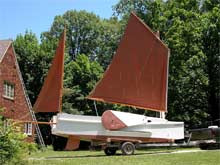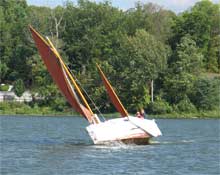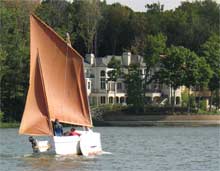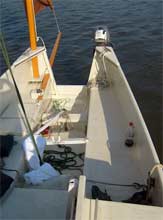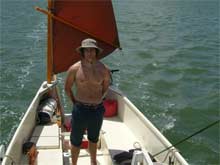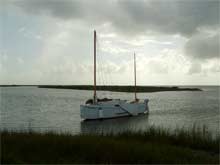
 Custom Search
|
|
| sails |
| plans |
| epoxy |
| rope/line |
| hardware |
| canoe/Kayak |
| sailmaking |
| materials |
| models |
| media |
| tools |
| gear |
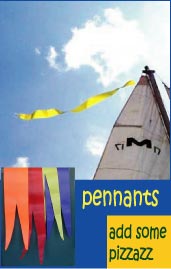 |
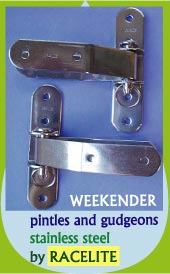 |
| join |
| home |
| indexes |
| classifieds |
| calendar |
| archives |
| about |
| links |
| Join Duckworks Get free newsletter Comment on articles CLICK HERE |
|
|
| Balancing the Helm |
by Ed Haile - Champlain, Virginia - USA |
| A New Look at Natural Course Stability In the old days it was said to be a boat’s finest point. Failing that, double headsails improved things for running the trade winds; then sheet-to-tiller arrangements for all tacks; then vane-steering. The autohelm was borrowed from power, and so on. The cruiser now has several self-steering options and the need for natural course keeping appears to be gone. Opinion is that even the best boats are limited to a few points of sail, all upwind. The only exception was the Spray, and she was unbearably slow.
John Letcher discusses the dynamics in the second chapter of his classic work, Self-Steering for Sailing Craft. (1) The chapter is titled “Natural Course Stability” and I do not believe anything can be added to his technical description of the forces at work and the inherent limitations of the concept, Joshua Slocum notwithstanding. If anything, he wrote the chapter to dismiss the concept. His book is about self-steering devices. At least that is the impression I had as I came away sadder. I did not realize I owned a different sort of boat, as boats go, a type that Letcher did not include in his consideration. The Terrapin is a Martha Jane sharpie, of plywood/epoxy construction, designed by Phil Bolger in 1986 for Elrow LaRowe of Common Sense Designs (2) names well known to amateur boat builders. One of the more popular of the slab-sided “box boat” fleet, two or three dozen Janes have been launched. I bought mine from an amateur builder in the spring of 1999. I found her narrow and tender. The boat’s underbody, crucial in any discussion of course keeping, is perfectly flat athwart, sweeping up bow and stern a bit more than a foot in typical sharpie rocker fashion, but completely clean of keel or skeg or even a through-hull fitting. She is held on course by a pair of leeboards and a large rudder that, with four inches leading the post, is nearly balanced. After one season I was dissatisfied enough to call her steering mushy. In short, the Terrapin is the kind of boat traditional opinion would consider least likely to possess any qualities at all of natural course keeping, and the truth is Letcher says as much in his praise of the tracking propensity of the full-length lead keel. Compared to that, a sharpie is a leaf on a pond.
On one downriver cruise, traveling alone as always, I found myself exhausted after four days of helming in the July sun. On another, I lasted five days, sleeping a couple after that. Once, I had to beat all the way home fifty miles. I had the tide with me, but I sat and steered by the luff for twelve hours non-stop. There had to be some way to get relief short of anchoring. At the 1999 Annapolis boat show I talked to makers of vane-steering devices, only to hear that a yawl’s mizzen blankets the vane. Since Martha is a yawl, tough luck, friend. I talked to autohelm people: more batteries and solar cells than I care to maintain, having no need of electricity for other purposes. So I turned to John Letcher’s unforgettable book. Sheet-to-Tiller Self-Steering The fact is, I went over chapter two rather quickly for chapter three, “Sheet-to-Tiller Self-Steering.” The opening is one of the loveliest passages in the literature of sail. The young voyager has just left Los Angeles for Hawaii on his first transoceanic passage in his twenty-foot sloop, and is determined to do or die rigging a self-steering device out of a collection of lines and blocks and elastic tubing he has brought along and dumped in the cockpit well. On the morning of the third day at sea, after much trial and error, “I had come upon the close-reaching arrangement that has served me ever since.”
I set up the same thing on the Terrapin. The parts and pieces cost me under fifty dollars and an hour or two of setup. I found some success off the wind, small success upwind. The culprit was friction in my rudder assembly. Worse, spring had to be readjusted for every change in wind strength. Course changes and tacks were clumsy. I was not crossing the Pacific Ocean; I was daysailing and cruising home waters on a slow, tidal river, never more than three miles wide, and in the fluky, criss-cross breezes of a Chesapeake summer. (3) I recalled Larry Pardey’s advice about windvane steering: Do your testing at least fifty miles offshore. Balancing the Helm A month passed. I was out daysailing on one of those perfectly shimmering days when there is plenty of sun but enough clouds for some cool in the air, and the breeze is 8 knots and steady. I began working the boards and sails more or less at random, and found that the boat was holding a course on a point of sail where I had not previously gotten her to balance. I chocked the helm amidships and began experimenting. The results got better and better. Immediately the next few days, I spent all my sailing time putting her through paces: more sheet, less sheet, main close-hauled, mizzen large, board down, halfway up, no board at all. Luckily the pleasant weather held throughout. Unlike John Letcher, I was not a thousand miles at sea, but I think I was as successful in as little time.
The sheet-to-tiller arrangement had in fact been overkill. Even better results were now obtained with the helm chocked amidships and the sails and boards in balance. She was doing splendidly on all points of sail on daysailing river tacks of one, two, three miles. It was all I had hoped for. I had mastered a set of controls. Three Essentials for Three Parameters Experiments completed, I counted three essentials. Foremost, the Terrapin’s rig is free-standing. There are no shrouds or stays. With nothing in the way, the sails can be perfectly set for 270° of wind direction. Second, the Terrapin sail plan leaves six feet between the main clew and the mizzen luff. The sails do not backwind each other. Third, the underbody profile is adjustable. Letcher’s second chapter had only discussed boats with a fixed keel and sloop rig. I found a good rule of thumb on the Terrapin was to set the sails for the course, then lower the board until she balanced. Provided these hull and rig characteristics, I found the three parameters of two sails and a board would induce lee helm or weather helm at will as a course correction. The yawl’s mainsail, when sheeted in, creates lee helm; the boat wants to fall off. The mainsail sheeted out causes weather helm, and the boats wants to head up. The mizzen, carried aft the rudder post, allows the boat to fall off the wind when released, and sheeted in increases weather helm. Lastly, the board lowered contributes to weather helm, raised causes the boat to fall off the wind. Moreover, none of these balancing configurations significantly compromises the best set of the sails. On the contrary, it is all done with the light touch.
Could the rudder become a fourth parameter? Could the tiller be chocked off center? This is what happens after all when we hand steer. And doesn’t everybody jam the helm in order to leave it for a moment’s freedom? Yes, but emphatically this is not balance. Balance is neutral helm. It hardly does to put the rudder in a tug-of-war with the rest of the boat. The slightest jar throws that out, as anybody knows who has gone after the sunburn lotion. In fact, everybody’s poor success here convinces most of us, quite prematurely, that our boats have no course-keeping ability. A cocked rudder induces drag for course-changing. The purpose of a rudder held amidships is to be a mighty skeg when the boat is otherwise in tune with going straight ahead. She needs her rudder precisely because it does not steer her but steadies her. Setting the Balance On downwind courses, the mainsail controls. In fact, the board is carried when running, leaving only two parameters, main and mizzen (the slightest bit of board down tugs her to weather). I have tried furling the mizzen to leave one, and the results are encouraging, but I expect the gain in equilibrium is offset by surrendering the mizzen’s drive. Close-Hauled In light airs, full and by, it is hard to find the groove. You have to play the mizzen sheet as much as you would the tiller, with little gain in leisure time. If there is a flaw in the system, it is there. Bear off, though, and the groove widens nicely. On the other hand, if the breeze freshens over ten knots, the Terrapin close-hauled seems all at once to achieve true self-steering equilibrium, truly comes into her own, loving the wind and chop, and moving ahead with a smooth power that reminds me of the cleanness of a multihull. She rolls over on her chine, lengthens her waterline, and her slab side and bottom present a very quiet right-angle vee to the nastiest whitecaps. Letcher writes that a sloop can chock the helm aweather and obtain the same effect. If the wind remains steady. But when does it ever? On my boat the mizzen is the necessary preventer in unsteady conditions and is adjusted until the weaving is at a minimum. I then really become another passenger, free to go below. In light airs, I finesse the boat across the wind with sails alone, just for the fun of it. I get a good turn of speed, sheet home the mizzen, then release the main, then release the mizzen the instant if luffs. As she tacks, the main is sheeted home first and the mizzen is sheeted just in time to correct her on course, then adjusted for balance. She jibes simply by sheeting in the main. Equilibrium or Inertia? Could one take the helm, steer off course three or four points, rechock it amidships, and expect the boat to find her way back (equilibrium)? Yes, on some tacks. At other times, it appears much like a musical instrument, in tune only for a time. It is hard to say more under conditions as variable by the minute as river sailing. Course holding is also affected by trim. Go aft on a small boat and she falls off; go forward and she heads up. Heel her sailing to windward and, like all boats, she wants to head up. Downwind, heeling has less effect. The difference is that altering trim when the helm is balanced makes her change course not to wander but to hold another course (neutral equilibrium). The Terrapin is not good at planing, though reaching in a strong breeze she will exceed hull speed. It does not at all throw her off balance. She surges and slows, surges and slows, in powerful gusts, without changing course. Balance is little affected by variation in wind strength. I have not been offshore with this or over Force 6 inshore. I have been in enough river chop to say that moderately heavy wave action does not knock it apart. Downwind, it is hard to imagine conditions that would broach it. All the same, a fixed helm will not supplement self-steering, so it is perhaps mainly for the inshore sailor.
In sum, the Terrapin happens to incorporate good course-keeping abilities because she has a clean underbody and two sails on two unstayed masts. Furnish any boat with the ability to use those three parameters, namely a rig that can induce both lee and weather helm on all sets of sail, and you have it. MARTHA JANE LOA 23´6´´ OR IN HANDBOOK FORM: Course changes downwind The boat is running on starboard jibe. The main and mizzen are squared, boards carried, helm chocked amidships. (1) To turn left towards jibe, sheet the main in. (2) To turn right towards luff, sheet the main out. (3) To turn further right towards luff, leave the main where it is & sheet the mizzen in. The boat is now sailing a broad reach on starboard jibe. (4) To turn right & go higher to windward, sheet in both main & mizzen & counter lee helm by lowering the leeboard a quarter. (5) To turn right & go higher yet to windward, lower the leeboard to balance the normal set of the sails, fine tuning with the mizzen. COURSE CHANGES UPWIND The boat is closed-hauled on port tack. The main is sheeted home, the mizzen likewise in light airs or barely luffing in a fresh breeze, the board is fully down, the helm chocked amidships. (6) To turn right & bear off towards jibe, the mizzen is eased & the main eased once the boat is on her new course. The mizzen fine-tunes. To turn further right towards jibe, repeat the sequence. When the boat fails to respond, the board is raised a quarter to induce lee helm. ___________ End Notes: 1. John S. Letcher, Jr. International Marine Publishing Company. Camden, Maine (1974). 2. now Common Sense Boats. 3. The Rappahannock River. ***** |
 |
